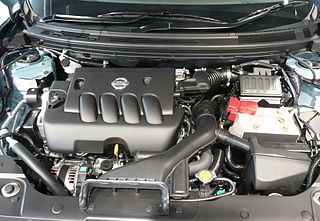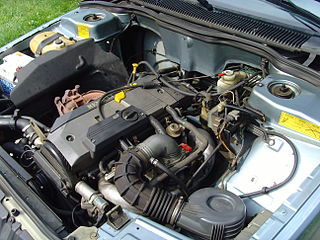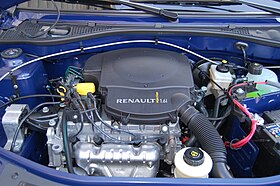
The Renault Laguna is a large family car that was manufactured and marketed by Renault for 21 years in three body styles: hatchback, coupé, and estate. The first generation Laguna was launched in 1994, the second generation was introduced in 2000, and the third generation was built from October 2007 until 2015.

The Renault 21 is a large family car produced by French automaker Renault between 1986 and 1994. It was also sold in North America initially through American Motors dealers as the Renault Medallion and later through Jeep-Eagle dealers as the Eagle Medallion. A total of 2,096,000 units were produced.
Multijet is Stellantis's term for its current common rail direct injection turbodiesel engine range. Most of the Fiat, Alfa Romeo, and Lancia range, as well as certain Chrysler, RAM Trucks, Jeep, and Maserati vehicles, are equipped with Multijet engines. Ownership of some Fiat Multijet designs is shared with General Motors as part of a settlement of the failed merger between the two auto conglomerates. The GM Powertrain Torino group in Turin, Italy, manages its interest in these engines. Some PSA Peugeot Citroën diesel engines are also rebadged JTD units, and vice versa. Fiat's common-rail diesel engine is also known as JTD, an initialism of Jet Turbo Diesel.

The Renault-Nissan MR engine family consists of straight-four 16-valve all-aluminium and water cooled automobile engines with variable valve timing co-developed by Renault and Nissan. Renault calls it the M engine. Other noteworthy features of this engine family include acoustically equal runner lengths and a tumble control valve for the intake manifold, a "silent" timing chain, mirror finished crankshaft and camshaft journals, and offset cylinder placement in an attempt for increased efficiency.

The PSA EW/DW engine is a family of straight-4 black-top automobile engines manufactured by the PSA Group for use in their Peugeot and Citroën automobiles. The EW/DW family was introduced in 1998 as a replacement for the XU engine. Some DW engines are produced as part of a joint-venture with Ford Motor Company.

The DLD is the name for an automobile engine family – a group of compact inline-four Diesel engines, involving development by Ford of Britain and/or PSA Group, and also Mazda where it is called the MZ-CD or CiTD. The Ford of Britain/PSA and joint-venture for the production of the DLD/DV was announced in September 1998. Half of the total engine count are produced at Ford of Britain's main plant at Dagenham, England and at Ford's Chennai plant in India, the other half at PSA's Trémery plant in France.

The Douvrin family is an all-aluminum inline-four automobile engine designed in the early 1970s and produced from 1977 to 1996 by Compagnie Française de Mécanique, a joint-venture between PSA and Renault located in the town of Douvrin in northern France. This engine is designed by the engineer Jean-Jacques His. It was produced in the same factory as the PRV V6, which also is sometimes known outside France as the "Douvrin" V6. The Douvrin engine is also referred to as the ZDJ/ZEJ engine by Peugeot, and as the J-type engine by Renault.

The HR is a family of straight-3 12-valve and straight-4 16-valve automobile engines with continuously variable valve timing, involving development by Nissan and/or Renault, and also Mercedes-Benz in the case of the H5Ht/M282. The designation of H engine is used by Renault, and M28x by Mercedes-Benz, to classify the family. There are three basic specifications of engine involving variations in engine architecture, or all-new architecture, with 72.2 mm (2.84 in), 75.5 mm (2.97 in) and 78 mm (3.07 in) bore diameter.

The Renault Fluence is a compact sedan produced by the French automaker Renault. The car was produced until 2016 at the Oyak-Renault plant in Bursa, Turkey. It was produced until the end of 2018 in Santa Isabel, Argentina, for the Latin American market. Its electric version is still produced in Busan, South Korea, for the market of the Asia-Pacific.

The Cléon-Fonte engine is a family of inline four-cylinder automobile engines developed and manufactured by Renault. It has also been called the Sierra engine, the C-engine, or the C-Type. It has been in continuous production by Renault or a licensee from 1962 to 2004. After about three decades of use in Renault's compact models, it was gradually replaced by the E-type engine from the late 1980s onward.

The Renault DiET engine also known as "D engine" or "D-Type" is a straight-4 automobile petrol engine from Renault designed to replace the existing Cléon-Fonte engine in the Renault Twingo.

F Renault engine is an automotive internal combustion engine, four-stroke, inline-four engine bored directly into the iron block, water cooled, with overhead camshaft driven by a timing belt, and with an aluminum cylinder head, developed and produced by Renault in the early '80s, making its appearance on the Renault 9 and 11. This engine is available in petrol and diesel versions, with 8 or 16 valves.

The Renault Energy engine also known as "E engine" or "E-Type" is an automotive gasoline four-stroke inline four cylinder internal combustion engine, with a sleeved water cooled cast iron block, equipped with 5 crankshaft bearings, an overhead camshaft driven by a toothed timing belt and an aluminum cylinder head with 8 overhead valves. Developed and produced by Renault in the late 1980s, the engine made its first appearance in the Renault 19.

The R-Type is a family of straight-4 turbocharged diesel engines developed by both Nissan and Renault, and also Daimler in regarding the R9M/OM626 engine. Released in 2011, it replaced the 1.9 dCi engine in Renault's range and the 2.0 dCi in the Nissan Qashqai, and in 2015, it also replaced the 2.0 dCi in the Renault Mégane as well. When launched, the engine produced 130 PS. Renault later introduced a higher-powered twin-turbocharged variant producing 160 PS.

The YD engine is a 2.2 and 2.5 L inline-four diesel engine from Nissan. It has a cast-iron block and aluminium head with chain driven twin overhead camshafts. The engine shares much of its architecture with the QR petrol engine.

The Renault Symbol, Clio or Thalia in some markets, is a subcompact sedan produced by the French automobile manufacturer Renault. It was introduced in late 1999, under the Clio Symbol name, as the derivative version of the second generation Renault Clio, and unlike the hatchback it was marketed only in those countries where saloons were traditionally preferred over hatchbacks, while it was not sold in Western Europe. It was actually sold in France, but only in overseas departments/regions and collectivities.

The M281 is a straight-three petrol engine produced by Mercedes-Benz since 2014.

















